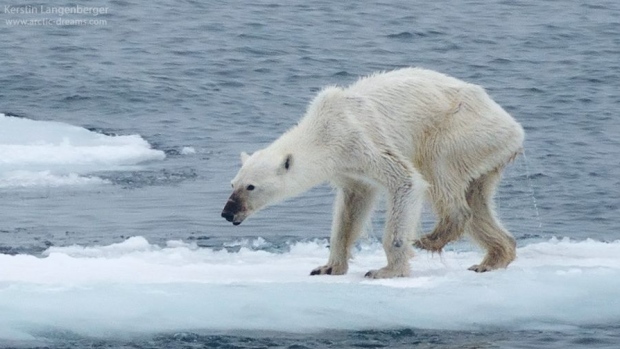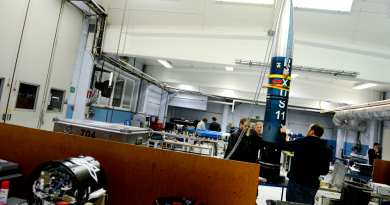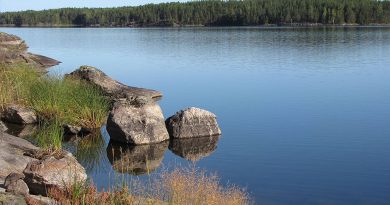The new face of climate change?

German tourists aboard a cruise through the Hinlopen Strait in Svalbard this summer were approaching a yellow dot on an ice-floe, hoping it was a polar bear, their trip’s main attraction.
As the dot took form about 300 meters away, it stood up, making it apparent it was indeed a bear — but it was not at all what they hoped to see. They saw a bear so skinny and frail the ship had to turn away for fear of causing it further harm. Photographer and tour guide Kerstin Langenberger said the sight rendered the people aboard speechless.
“They were really sad and silent,” said Langenberger. “Everyone wants to see a polar bear, that’s the main reason they go to Svalbard on the ship. But nobody wants to see a dying polar bear.”
Viral post
When she got back online in August, she posted the picture to Facebook, stating that ice is disappearing, bears are dying and that “every little action we do to change our ways is a step in the right direction.”
It was shared more than 53,000 times and — along with another grim image of a polar bear — making the rounds on social media and elsewhere on the Internet in recent weeks.
The other photograph was also in Svalbard, but of a dead bear. It was taken by a National Geographic fellow in 2014 and posted to Instagram last week.
“These bears were so skinny, they appeared to have died of starvation, as in the absence of sea ice, they were not able to hunt seals,” wrote photographer Paul Nicklen. “In all of my years of growing up in the Arctic and later, working as a biologist, I had never found a dead polar bear. It is now becoming much more common.”
Making the link?
But can the fate of individual bears be tied directly to climate change?
“If you try and say, ‘Well, here’s a bear being killed by global warming,’ that’s not appropriate,” said Steven Amstrup, a chief scientist for the conservation group Polar Bears International.
That doesn’t mean there’s no connection, Amstrup said.
“The important message here is that ultimately if we don’t deal with greenhouse gas emissions, we’ll see more of these pictures,” he said.
Changing eenvironment
Amstrup has been studying polar bears for 30 years. A report he co-authored tracked southern Beaufort Sea populations in the U.S. and Canada between 2001 and 2010, documenting a decline of 40 percent. The report also concluded polar bear rates of survival were contingent upon the abundance of sea ice.
Polar bears aren’t the best swimmers, and they need ice to use as camouflage, he explained. They most often prey on seals, which don’t necessarily need ice, but they will hang out on it if it’s there. The ice makes it easier for the bears to stalk the seals by hiding behind it before they pounce, or having to swim less to get to them. Without ice, polar bears don’t have that floating dock and the seals can easily spot them.
One was recently filmed swimming underwater much longer than usual in an apparent — and unsuccessful — attempt to stalk a seal in the absence of ice.
Interpreting images
Melting ice makes it harder for the bears to nab seals and pushes them onto land, Amstrup said, which is further from their prey, and also closer to observers.
“A number of my colleagues and I have all chimed in and said, ‘Well, yeah, we’ve all seen that type of thing,’” he said. “It may be that at some point, someone will try to start to tabulate how many photographs of these emaciated bears we’re seeing.”
For now, he said, the data just speaks to survival rates, not whether their starvation is a direct result of climate change.
“I have to agree. I can’t tell if this bear has become so thin because of climate change or not,” said Langenberger. “But if you just open your eyes and use your brain then it’s very clear that if there’s less ice than before and there’s less food than before because of climate change, then the starving of polar bear is very likely because of climate change.”
Amstrup and Langerberger also agree about the ultimate impact of the images on viewers; they’re useful, Amstrup said, as an illustrative example for those who “just don’t understand the costs of climate change.”
Related stories from around the North:
Canada: Study shows polar bears relocating to icier Canadian Archipelago, Alaska Dispatch News
Norway: Russia – Norway polar bear count nixed, Barents Observer
Russia: Submariners feed polar bears with garbage, Barents Observer
United States: Scientists seek cause of patchy baldness in some Beaufort Sea polar bears, Alaska Dispatch



